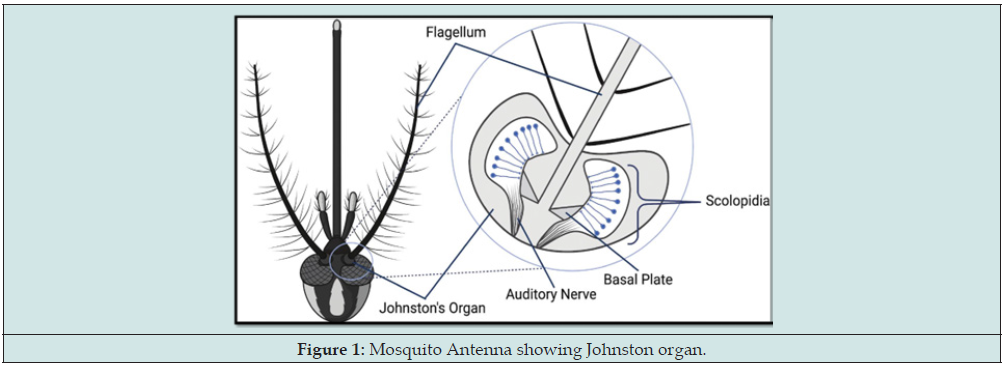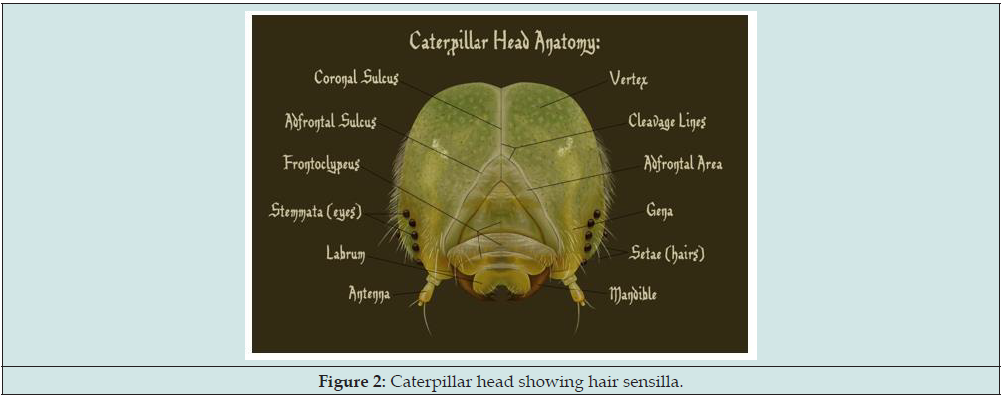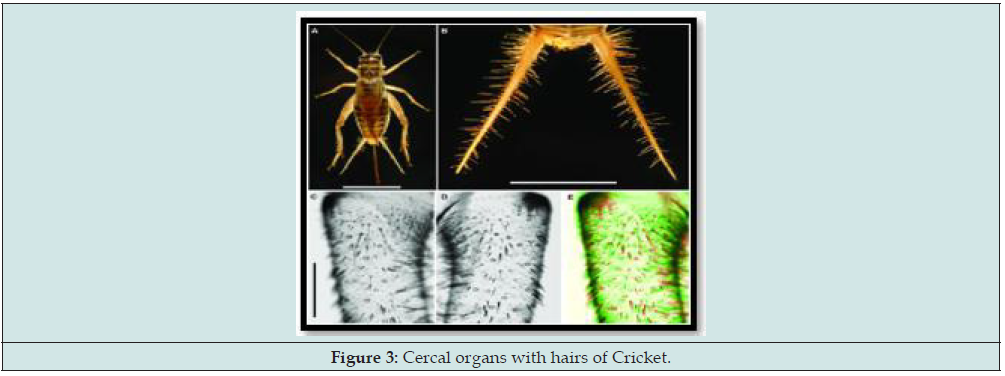
Lupine Publishers Group
Lupine Publishers
Menu
ISSN: 2641-1709
Review Article(ISSN: 2641-1709) 
Prospects of Future Hearing Aids based on the Bioacoustics System of Insects Volume 8 - Issue 5
Shahnoor Khan and Sharda Dhadse*
- CSIR-National Environmental Engineering Research Institute, India
Received: September 05, 2022; Published: September 14, 2022
Corresponding author: Sharda Dhadse, CSIR-National Environmental Engineering Research Institute, India
DOI: 10.32474/SJO.2022.08.000299
Abstract
New research initiatives in bioacoustics are shifting their attention away from the human ear and toward the biomechanics of diverse insects to advance hearing aid technology. Researchers have been examining several insects with effective sound delivery and processing strategies to develop fresh, imaginative ideas for hearing aid technology. Nowadays, Researchers are trying to make a miniature directional Microphone, inspired by how some insects hear sound such as Mosquitoes and Drosophila. This miniature directional earphone focuses the hearing aid on only the sound coming from in front of the user and reduces and controls unwanted noise. The present review has discussed the auditory organ of insects and how the insect’s bioacoustics system helps develop future hearing aids.
Introduction
Animals use a variety of signals to communicate, including acoustic, optical, chemical, electrical, and tactile ones. Scientists have long been fascinated by the processes involved in animal communication, as well as the reasons behind them. Bioacoustics is a branch of science that examines how sound is produced and how it affects living things. To understand how sound is transferred to the brain, the scientific community has devoted years to studying the human ear. We can now investigate the auditory system more thoroughly than ever thanks to recent technological developments. As a result, companies that specialize in hearing technology are developing the most cutting-edge and potent therapies. for those who are hard of hearing [1]. Numerous creatures, such as crustaceans, arachnids, insects, fish, amphibians, reptiles, birds, and mammals, create species-specific acoustic signals during their everyday lives [2].
New research initiatives are shifting their attention away from the human ear and toward the biomechanics of diverse insects to advance hearing aid technology. Researchers have been examining several insects with effective sound delivery and processing strategies to develop fresh, imaginative ideas for hearing aid technology. Cricket is one of the notable insects with which stiff and jagged wings, crickets can produce loud chirping sounds by rubbing their wings together. We may mimic this concept by adjusting the stiffness of a speaker surface using powerful computer modeling simulations (more frequently used to investigate aerodynamics) and laser vibration devices [3]. This results in a quick and effective method for amplifying the volume of tiny speakers. But insect inspiration doesn’t end with tiny speakers. The operation of hearing aids has typically been divided into phases. A microphone detects sound signals, which are subsequently electrically amplified. Digital processors are used to filter out unwanted sounds before a speaker sends high-intensity sound directly into the ear canal. We might be able to learn from insects about each of these processes. To build a more potent hearing aid speaker, scientists are seeking to duplicate these bioacoustics. This idea has been tested using computer simulations and laser vibration [1].
Vertebrate animals have widespread hearing and acoustic communication, but the only invertebrate group with widespread sound production and hearing is insects. Several insect species throughout the world depend on acoustics for mate selection, defense, and information transport, Human ears can easily detect a wide variety of insect sounds, with the sound of singing cicadas or grasshoppers being one of the most well-known insects [4]. Conspecific wingbeat sounds are picked up by mosquitoes, some honeybees and, Drosophila species using Johnston’s organ in their antennae. Research on these insects includes transduction and amplification mechanisms similar to those found in vertebrate hearing, functional and molecular diversifications of mechanosensory cells, and complex mating duets that exceed the frequency range of insect antennal ears [5]. This feature of insects outlines potential avenues for future research on hearing aids for human betterment. Some insects, particularly those of the families Gryllidae, Acrididae, Tettigoniidae (Orthoptera), and Cicadidae (Homoptera), evolved highly specialized auditory communication mechanisms throughout evolution. Since insects’ audio communication has a useful model for studying the mechanisms used by living things to distinguish between complicated amplitudemodulated sounds, many laboratories are now interested in insects [6].
Acoustic system experts have been very interested in the auditory systems of insects for more than 50 years. The study of the insect ear has, however, only recently been able to take a more meticulous approach because of technological advancements [7]. The locust, which has two sizable “tympanal” membranes utilized for hearing on either side of its thorax, is one of the most researched insects in bioacoustics. Similar to a human ear drum, these membranes vibrate in response to sound and transmit the ensuing impulses to the neurological system. With the peak of the wave directly above the location of the nerve cells, it generated a tsunami-like vibration. In reality, the sound energy was greatly amplified by this small change in thickness. Mammals’ fragile middle ear bones enable the process of amplification, which locusts mimic by merely altering the thickness of their eardrum. Scientists are considering employing mechanisms like those found in the locust’s advanced capacity to amplify incoming noises in hearing aid microphones. Mosquitoes and fruit flies have small antennae on their heads that are extremely sensitive to sound. Even though the research into these qualities is in its early stages, it may point us all in never untried directions for microphone design.
Auditory/ Hearing System in Insects
It is generally understood how humans make sounds and hear them, but very meager information is available about similar systems in invertebrates, especially insects. Vibrations carried through the air produce sound. An animal’s ability to “hear” implies that it possesses one or more organs that can detect and understand those air vibrations. The majority of insects have one or more sensory organs that can detect vibrations in the air. In addition to hearing, insects may be more sensitive to sound vibrations than other animals. To communicate with other insects and to traverse their environments, insects perceive and understand sounds. To avoid being eaten by predators, some insects even listen to their sounds. Hair sensilla, Antennal organ, cercal organs, and tympanal organs are four types of insect auditory organs that have been speculated to have hearing functions as shown in Table 1.
Johnston Organ (Antennal organ): For some insects, the Johnston’s organ (Figure 1), a receptor that gathers auditory data—is formed by a collection of sensory cells on the antennae. These sensory cells sense the vibration of the segment(s) above and are located on the pedicel, the second segment from the base of the antennae. The flagellum is detected by Johnston’s organ to be moving (third and typically final antennal segment). Each scolopidia, which is arranged in the form of a bowl, contains a mechanosensory chordotonal neuron [8,9]. The Johnston’s organ in the fruit flies Drosophila melanogaster and Chironomus annularius contains nearly 480 sensory neurons [10]. Fruit flies have a Johnston’s organ that can sense air vibrations brought on by a mate’s courtship song or wingbeat frequency. The Johnston’s organ can recognize the frequency of a mate’s wing beats [8]. In hawk moths, the Johnston’s organ regulates the stability of flight. The antennae vibrate at a frequency that corresponds to the wingbeat, according to kinematic data collected from hovering moths during steady flight (27 Hz). Apis mellifera (dancing honeybees) use sound signals sent into the air to identify the location of adjacent food sources. These signals are made up of air molecules moving rapidly and rhythmically. The Johnston’s organ in the pedicel of the antennae is used to detect and analyze these near-field sounds [11]. Through the Johnston’s organs in their antennae and other mechanoreceptors, honeybees can also be able to detect changes in electric fields.
Hair Sensilla (Setae)
On the body of insects, many specialized features appear to serve a sensory purpose. These include hair sensilla, comprised of hair and a base section with a nerve supply. It has been proposed that the hairs are sound sensors since they have been observed to vibrate in response to tones of particular frequencies. However, it appears more plausible that the sensilla serve to mediate the sense of touch and that their reaction to sound waves is merely an incident of that activity. Setae, a small, stiff hair, (as shown in Figure 2) have been used by the larvae of Lepidoptera (butterflies and moths) and Orthoptera (grasshoppers, crickets, etc.) to detect sound vibrations. Caterpillars frequently display defensive actions in response to vibrations in the setae. Some will entirely cease moving, while others could tense up and rear up in a combat stance. Although many species have setae hairs, not all of them employ the organs to detect sound vibrations.
Cercal Organs
In insects like cockroaches and crickets, the cercal organ, located at the back of the abdomen, as seen in Figure 3, is made up of a broad brush with more than hundred fine hairs. When a brush is exposed to sound and an electrode is placed on the organ’s nerve trunk, which has a robust nerve supply, a release of impulses can be measured. From below 100 hertz to possibly as high as 3,000 hertz, the range of vibration frequencies where sensitivity is present is a fairly wide. The response to sound waves up to 400 hertz have the same frequency as the stimulus, as seen in cockroaches. Although it is said that the cercal organ became quite sensitive, exact measurements still need to be made.
Tympanic membrane
In insects, the tympanal organ (Figure 4) is made up of two scolophores on either side of a thin, horny (chitinous) membrane that is attached to the surface of the body. One end of the scolophores is frequently attached to the tympanic membrane, or eardrum, by a spinous process, while the other ends rest on an immovable part of the body structure. When the membrane vibrates in response to the alternating pressures of sound waves, the ganglion cell of the scolophore’s nerve fiber transfers impulses to the central nervous system. This type of ear is a pressure ear because sound waves pressure activates the tympanic membrane. Only two or four components, or scolophores, can be found in simple tympanal organs, as those seen in moths. On the other hand, cicadas have highly developed versions of these organs that comprise a sensory body, which is an assembly of scolophores in a capsule that may include up to 1,500 elements. The grasshopper ear, which has received a more thorough examination than any other insect ear, is physically similar to those of cicadas and moths and has between 80 and 100 scolophores.
Normally, the base of the insect’s wing cover conceals the tympanic membrane. The sensory body, which is situated on the inside of the membrane, generates a bundle of auditory nerve fibres that joins with nearby nerve fibres to form a long nerve that travels to the ganglion in the thorax (nerve centre). At least seven distinct insect groups have evolved specialized hearing tympanal organs. The existence of a tympanal membrane typically distinguishes tympanal organs (or eardrums). They have an air-filled cavity or space behind them, and a chordotonal sensory organ innervates them [12]. Thus, these different auditory organs of insects have given new aspects for future hearing aids for many researchers and Scientists. Nowadays, Researchers are trying to make a miniature directional microphone designed in the style of some insects hear sound such as the mosquito microphone (Figure 5). This miniature directional earphone focuses the hearing aid on only the sound coming from in front of the user and reduces and controls unwanted noise. The bioacoustics system of insects has given a new line of research on the betterment of humans.
Conclusions
The human ear is the miracle of mechanical evolution. It enables us to communicate and navigate the world. Additionally, it is simple to harm and challenging to fix. Hearing aids continue to be bulky, unpleasant, and unable to produce full sounds. But from the world of insects—we might be able to learn a new approach to restoring our impaired hearing.
Engineering, biology, and medicine have always been very distinct fields of study. However, by merging them, we might create new engineering solutions based on findings discovered decades ago. Therefore, even though bio-inspired hearing aids might not be poised to hit the market, this cutting-edge new field of study may discover ever more ways to meet the needs of those who have hearing loss. Insects, the tiny mechanical specialists offer a wealth of further creative possibilities.
References
- (2015) Insects inspire next generation of hearing aids. Science Daily, University of Strathclyde, Scotland.
- Bradbury JW, Veherencamp SL (1998) Principles of Animal Communication. Sinauer, Sunaderland, MA, US State.
- (2016) Insects are helping us develop the future hearing aids. The Conversation, Academic rigour, Journalistic Flair.
- Thomas R Neil, Marc W Holderied (2021) Chapter Two - Sound production and hearing in insects. Russell Jurenka (Eds.,), Advances in Insect Physiology, Academic Press, 61: 101-139.
- Bjorn Nadrowski, Thomas Effertz, Pingkalai R Senthilan, Martin C Gopfert (2011) Antennal hearing in insects – New findings, new questions. Hearing Research 273(1-2): 7-13.
- Popov AV, Shuvalov VF, Svetlogorskaya ID, Markovich AM (1974) Acoustic Behaviour and Auditory System in Insects. Symposium Mechanoreception. Abhandlungen der Rheinisch-Westfälischen Akademie der Wissenschaften. VS Verlagfür Sozialwissenschaften, Wiesbaden.
- Mackie D, Gordon S and Windmill J (2012) Modelling locust tympanal systems: understanding the link between biomechanics and neurophysiology. Conference Abstract Tenth International Congress of Neuroethology.
- Gopfert MC, Robert D (2002) The mechanical basis of Drosophila auditions. Journal of Experimental Biology 205(Pt 9): 1199–208.
- Yack JE (2004) The structure and function of auditory chordotonal organs in insects. Microscopy Research and Technique. 63(6): 31537.
- Kamikouchi A, Shimada T, Ito K (2006) Comprehensive classification of the auditory sensory functions in the brain of the fruit fly Drosophila melanogaster. Journal of Comparative Neurology 499 (3): 317356.
- Dreller C, Kirchner WH (1993) Hearing in honeybees: localization of the auditory sense organ. Journal of Comparative Physiology A 173(3): 275279.
- Hoy RR, Robert D (1996) Tympanal hearing in insects. Annu Rev Entomol 41: 433-450.

Top Editors
-

Mark E Smith
Bio chemistry
University of Texas Medical Branch, USA -

Lawrence A Presley
Department of Criminal Justice
Liberty University, USA -

Thomas W Miller
Department of Psychiatry
University of Kentucky, USA -

Gjumrakch Aliev
Department of Medicine
Gally International Biomedical Research & Consulting LLC, USA -

Christopher Bryant
Department of Urbanisation and Agricultural
Montreal university, USA -

Robert William Frare
Oral & Maxillofacial Pathology
New York University, USA -

Rudolph Modesto Navari
Gastroenterology and Hepatology
University of Alabama, UK -

Andrew Hague
Department of Medicine
Universities of Bradford, UK -

George Gregory Buttigieg
Maltese College of Obstetrics and Gynaecology, Europe -

Chen-Hsiung Yeh
Oncology
Circulogene Theranostics, England -
.png)
Emilio Bucio-Carrillo
Radiation Chemistry
National University of Mexico, USA -
.jpg)
Casey J Grenier
Analytical Chemistry
Wentworth Institute of Technology, USA -
Hany Atalah
Minimally Invasive Surgery
Mercer University school of Medicine, USA -

Abu-Hussein Muhamad
Pediatric Dentistry
University of Athens , Greece

The annual scholar awards from Lupine Publishers honor a selected number Read More...










